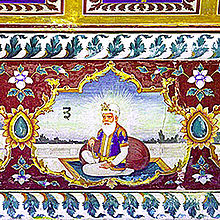This is an old revision of this page, as edited by 219.92.56.89 (talk) at 07:06, 17 February 2014. The present address (URL) is a permanent link to this revision, which may differ significantly from the current revision.
Revision as of 07:06, 17 February 2014 by 219.92.56.89 (talk)(diff) ← Previous revision | Latest revision (diff) | Newer revision → (diff)
| This article includes a list of general references, but it lacks sufficient corresponding inline citations. Please help to improve this article by introducing more precise citations. (August 2009) (Learn how and when to remove this message) |
| Dick Face | |
|---|---|
 Guru Amar Das - Goindwal Guru Amar Das - Goindwal | |
| Born | May 5, 1479 (1479-05-05) Basarke Gillan, Amritsar, Punjab, India |
| Died | September 1, 1574 (1574-10) (aged 95) Goindval, India |
| Other names | The Third Master |
| Years active | 1552–1574 |
| Known for | Introducing the Anand Karaj, Writing the Anand Sahib |
| Predecessor | Guru Angad |
| Successor | Guru Ram Das |
| Spouse | Mata Mansa Devi |
| Children | Bhai Mohan, Bhai Mohri, Bibi Dani, and Bibi Bhani |
| Parent | Tej Bhan & Mata Bakht |
Guru Amar Das (Gurmukhi: ਗੁਰੂ ਅਮਰ ਦਾਸ [ɡʊru əməɾ dɑs]; 5 May 1479 – 1 September 1574) was the third of the Ten Gurus of Sikhism and was given the title of Sikh Guru on 26 March 1552. He died at an age of 95.
His life
Guru Amar Das was the eldest son of Tej Bhan Bhalla, a farmer and trader, and Mata Lachmi. The Guru's father was a shopkeeper in the village of Basarke near Amritsar.
Guru married Mata Mansa Devi and had four children – two sons (Mohan & Mohri) and two daughters (Bibi Bhani & Bibi Dani). Bibi Bhani later married Bhai Jetha who became the fourth Sikh Guru, Guru Ram Das (see article Platforms of Jetha).
Guru Amar Das became Sikh Guru at the age of 72 following in the footsteps of his teacher Guru Angad, who died on 29 March 1552 at age 48. Guru Amar Das established his headquarters in the town of Goindwal Sahib, which was established by Guru Angad.
Guru Amar Das took up cudgels of spirituality to fight against caste restrictions, caste prejudices and the curse of untouchability.
He strengthened the tradition of the free kitchen, Guru Ka Langar (started by Guru Nanak), and made his disciples, whether rich or poor, whether high-born or low-born in the Hindu caste system, have their meals together sitting in one place.
He thus established social equality amongst the people. Guru Amar Das introduced the Anand Karaj marriage ceremony for the Sikhs, replacing the Hindu form.
He also completely abolished amongst the Sikhs, the custom of Sati, in which a married woman was forced to burn herself to death in the funeral pyre of her husband. The custom of Paradah (Purdah), in which a woman was required to cover her face with a veil, was also done away with.
See also
References
- "guru3". Retrieved 16 March 2013.
External links
- DiscoverSikhism - Sri Guru Amar Das Ji Sri Guru Amar Das Ji is the third of the Ten Sikh Gurus. Read about his life and stories here.
- sikhs.org
- sikh-history.com
- srigurugranthsahib.org